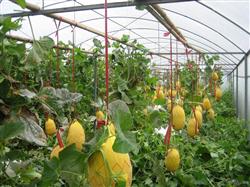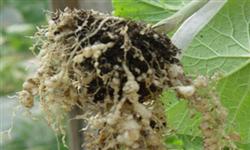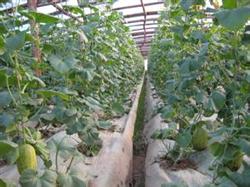Key points of high-yield cultivation techniques of Hami melon

1. Sowing and cultivating strong seedlings at the right time from the end of December to the first ten days of January of the second year, with a seedling age of 30 days. Before sowing, the seeds were disinfected, soaked and germinated. Nutritious soil is selected from soil or paddy soil that has not been planted with melon crops. 2000 kg of rotten manure and 10 kg of calcium superphosphate are used as base fertilizer every 667m2. In order to prevent diseases, 50% carbendazim 3 kg was applied every 667 square meters to disinfect the soil. Second, timely transplanting and reasonable close planting of cantaloupe should build a greenhouse 15 days before planting, preferably into a greenhouse 4 to 5 meters wide, with a convex and high border of 2 meters wide and 15 centimeters high, covered with plastic film, and planting rows in the middle of the border. The seedlings were transplanted with 2 leaves and 1 heart, and 600 seedlings were planted with 667 square meters. Note that the ground temperature should be above 15 ℃ when transplanting. Third, fertilizer and water management shall apply sufficient base fertilizer, applying 50 kg of nitrogen, phosphorus and potassium compound fertilizer every 667m2, or 4000 kg of rotten manure. All of the base fertilizer 2 beat 3 were deeply applied 15 days before planting, and the other 1 big 3 furrows were applied at 10 cm of the planting row, covered with soil and plastic film. Do not apply fertilizer before fruiting melons, and apply expanded melon fertilizer when melons grow to the size of duck eggs. Cantaloupe is very sensitive to water, the soil should be dry rather than wet, but should not be too dry. 4. Temperature management from planting to survival, the temperature should be controlled above 18 ℃ at night, 25: 30 ℃ at day, 15 ℃ above at night and 30 ℃ at day. The main measures to control temperature are timely ventilation, small ventilation, big ventilation, especially at noon in sunny days. During the melon sitting period, the temperature was 25: 28 ℃ during the day and 15: 18 ℃ at night. After sitting melon, the greenhouse temperature was kept at 30: 35 ℃ during the day and 15: 18 ℃ at night. Fifth, pruning and heart-picking generally adopt the method of double-vine pruning, that is, when the seedlings have 2 or 3 true leaves, the growing points are removed with bamboo sticks to promote the occurrence of sub-vines in the following two nodes, and Sun vines grow on the sub-vines, and the Sun vines below 5-6 knots are wiped out. Use the middle grandchildren with more than 5-6 knots to bear melons. In general, the female flower occurs in the first node, and the overgrowth of the late female flower is easy to be erased. at the same time, the sun vine with more than 12 nodes should be erased and the sun vine with 7 nodes and 12 nodes should be preserved. After Sun Meng knot melon, keep the first leaf of melon to pick the heart. Sun Min, who does not sit on melons, leaves 2 leaves to pick his heart. Pick the heart when the vine is 20 leaves. Pruning must be timely and should be carried out on a sunny day to facilitate wound healing. Sixth, the time of artificial pollination should be before 10:00 or after 3 p.m., or release bees for insect pollination, or use efficient zigualing to assist melon sitting. Pest control mainly includes aphids and red spiders. Deltamethrin can be used to control. The main diseases are powdery mildew, anthracnose, vine blight, downy mildew and bacterial angular spot, which can be controlled by powder rust, chlorothalonil, metalaxyl manganese zinc, agricultural streptomycin and so on.
- Prev

Cantaloupe root knot nematode disease
Root-knot nematode disease is an important disease of Hami melon, which occurs and distributes in some areas. It can occur in protected and open fields. The disease is more serious in autumn. Infection in seedling stage has a great impact on production. After the disease, the rate of diseased plants is often more than 60%, which obviously affects the production of Hami melon. The symptoms are mainly harmful to the root system and occur on the main root and lateral root.
- Next

Cultivation techniques of cantaloupe moving eastward
The cultivation experiment of cantaloupe moved eastward shows that it is very easy to cultivate cantaloupe around Beijing. The sandy loam soil with less than 1% salt and 1.5% humus is the best; the temperature is 28-38 ℃, the relative humidity is 15%-70%, the light is 30,000 lux (more than 8 hours a day), and the sea is the best.
Related
- Moge, come on! The staff of the peasant association in the producing area of cantaloupe were frightened when the crowd gathered.
- Causes and Solutions of low Fruit setting rate of Apple
- Symptoms and control measures of passion fruit virus disease
- Fruit growing lesson: how do apple orchards keep high yields?
- Can you build orchards in the mountains? What are the pros and cons?
- How to manage the coloring period of Crisson grape?
- This paper introduces the processing technology of two kinds of fig products.
- How much is a month for retired teachers in rural areas by 2020?
- How can strawberry planting increase sugar content? We should pay attention to management in many aspects.
- What are the cultivation techniques on how to improve the yield of golden fruit?

